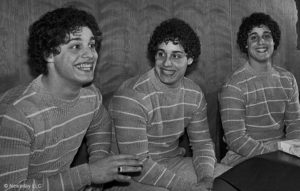Click here to listen to the interview with Tim Wardle.
As the documentary THREE IDENTICAL STRANGERS opens, Bobby Shafran, one of the eponymous strangers, notes that the story he’s about to tell is unbelievable. And it is. But the way that Tim Wardle’s dark meditation on good intentions gone very wrong unfolds, the story of how the three identical triplets separated at birth found each other at the age of 19, is the least of it.
 In 1980 Bobby was a newly arrived freshman at an upstate New York college. To his surprise, he was greeted enthusiastically by total strangers, including attractive women who kissed him on the mouth as a way of welcoming him back to the campus. His confusion turned to stunned disbelief when he discovered the reason for the confusion was another 19-year-old named Eddy, who not only shared the same birthdate and adoptive status, but also his exact appearance. The news was picked up by a local paper, and in short order David, the third triplet, saw his face on those two people, and the three were reunited. What ensued was a media frenzy. They were everywhere, bright eyes and infectious smiles, in identical clothes, finishing each other’s sentences, and mirroring each other’s body language, and parlaying their fame into a restaurant (suitably named Triplets), where the party atmosphere and burgeoning profits made for the fairy tale ending everyone expected.
In 1980 Bobby was a newly arrived freshman at an upstate New York college. To his surprise, he was greeted enthusiastically by total strangers, including attractive women who kissed him on the mouth as a way of welcoming him back to the campus. His confusion turned to stunned disbelief when he discovered the reason for the confusion was another 19-year-old named Eddy, who not only shared the same birthdate and adoptive status, but also his exact appearance. The news was picked up by a local paper, and in short order David, the third triplet, saw his face on those two people, and the three were reunited. What ensued was a media frenzy. They were everywhere, bright eyes and infectious smiles, in identical clothes, finishing each other’s sentences, and mirroring each other’s body language, and parlaying their fame into a restaurant (suitably named Triplets), where the party atmosphere and burgeoning profits made for the fairy tale ending everyone expected.
Wardle employs elegant cinematic idioms to unravel a sordid mystery in which the high and mighty use unwitting pawns in pursuit of a perceived greater good, while the debate about nature v. nurture plays out as a disquieting subtext that serves to illuminate the human capacity to see what it expects, or worse, wants to see. He also uses tight close-ups for the contemporary interviews, giving the triplets an individuality that they themselves eschewed, and that the public gaze refused to acknowledge when they first reunited. Those interviews start out with giddy delight (the image David’s Aunt Hedy shares is of them rolling around on the floor like a pile of puppies shortly after meeting) and slowly, almost imperceptibly turn dark, and we are swept along, first as delighted bystanders, and then, with the most subtle and graceful of foreshadowing, as bystanders overcome with dread. The twists and turns are worthy of a film noir, but the reality uncovered about the nature of free will and our collective capacity for falling prey to tunnel vision makes this a film as much about the viewer as about anyone on screen.
Throughout THREE IDENTICAL STRANGERS, clips of the triplets’ early years of reunion are replayed, identical in image as the triplets themselves, but as the film progresses, with the context rearranged, and we are left to wonder why details weren’t noticed before, why questions, obvious in hindsight, weren’t asked amid the media hype. Thus are our unconscious prejudices and preconceived notions about how the world works are revealed, and our comfortable remove from this intriguing story is gone. It is a stunning revelation, and it is what elevates Wardle’s film beyond mere reportage as it transports us from the collective comfort zone we normally occupy, and hands us some bracing insight for which we didn’t ask, but at which we can be nothing but astonished.
Your Thoughts?